
During the existence of the Soviet Union, different governments existed within the Crimean Peninsula. From 1921 to 1936, the government in the Crimea was known as the Crimean Autonomous Socialist Soviet Republic and was an Autonomous Soviet Socialist Republic within the Russian Soviet Federative Socialist Republic (SFSR); from 1936 to 1945, the name was slightly altered to the Crimean Autonomous Soviet Socialist Republic.
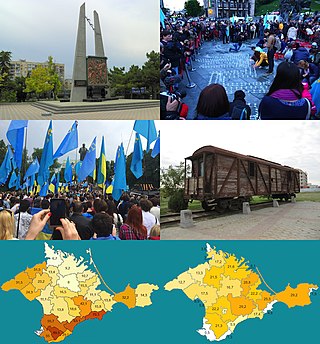
The deportation of the Crimean Tatars or the Sürgünlik ('exile') was the ethnic cleansing and the cultural genocide of at least 191,044 Crimean Tatars which was carried out by Soviet Union authorities from 18 to 20 May 1944, supervised by Lavrentiy Beria, chief of Soviet state security and the secret police, and ordered by the Soviet leader Joseph Stalin. Within those three days, the NKVD used cattle trains to deport the Crimean Tatars, mostly women, children, and the elderly, even Communist Party members and Red Army members, to the Uzbek SSR, several thousand kilometres away. They constituted one of the several ethnicities which were subjected to Stalin's policy of population transfer in the Soviet Union.
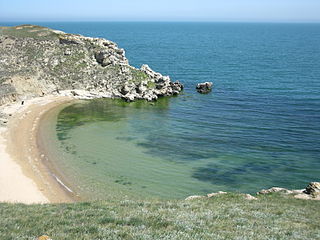
Lenine Raion or Yedy-Kuiu Raion was one of the twenty-five districts of the Autonomous Republic of Crimea in Ukraine until its abolition in 2020. It continues to be used by the Russian administration known as the Republic of Crimea, as Russia has occupied Crimea since 2014.
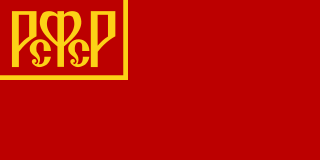
The Russian Soviet Federative Socialist Republic, previously known as the Russian Soviet Republic and the Russian Socialist Federative Soviet Republic, and unofficially as Soviet Russia, was an independent federal socialist state from 1917 to 1922, and afterwards the largest and most populous constituent republic of the Soviet Union (USSR) from 1922 to 1991, until becoming a sovereign part of the Soviet Union with priority of Russian laws over Union-level legislation in 1990 and 1991, the last two years of the existence of the USSR. The Russian SFSR was composed of sixteen smaller constituent units of autonomous republics, five autonomous oblasts, ten autonomous okrugs, six krais and forty oblasts. Russians formed the largest ethnic group. The capital of the Russian SFSR and the USSR as a whole was Moscow and the other major urban centers included Leningrad, Stalingrad, Novosibirsk, Sverdlovsk, Gorky and Kuybyshev. It was the first socialist state in history.
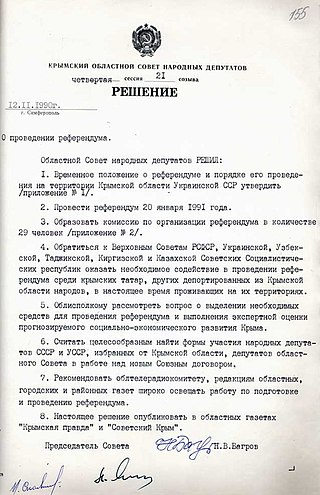
A referendum on autonomy was held in the Crimean Oblast of the Ukrainian SSR on 20 January 1991, two months before the 1991 All-Union referendum. Voters were asked whether they wanted to re-establish the Crimean Autonomous Soviet Socialist Republic, which had been abolished in 1945. The proposal was approved by 94% of voters.
Hirne is a rural settlement in the Yalta Municipality of the Autonomous Republic of Crimea, a territory recognized by a majority of countries as part of Ukraine and annexed by Russia as the Republic of Crimea.
Kuibysheve is a rural settlement in the Yalta Municipality of the Autonomous Republic of Crimea, a territory recognized by a majority of countries as part of Ukraine and annexed by Russia as the Republic of Crimea.
Vysokohirne is a rural settlement in the Yalta Municipality of the Autonomous Republic of Crimea, a territory recognized by a majority of countries as part of Ukraine and annexed by Russia as the Republic of Crimea.
Soniachna Dolyna or Solnechnaya Dolina(Ukrainian: Сонячна Долина; Russian: Солнечная Долина; literally, Sunny Valley) is a village in the Sudak Municipality of the Crimea, a territory recognized by a majority of countries as part of Ukraine and annexed by Russia as the Republic of Crimea.
Myndalne or Mindalnoye is a village in the Sudak Municipality of the Crimea, a territory recognized by a majority of countries as part of Ukraine and annexed by Russia as the Republic of Crimea.
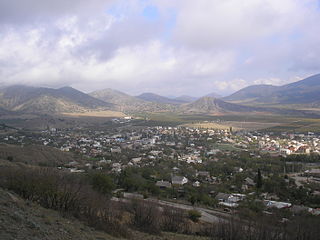
Vesele or Vesyoloye is a village in the Sudak Municipality of the Crimea, a territory recognized by a majority of states as part of Ukraine and annexed and claimed by Russia as the Republic of Crimea.
Bahativka or Bogatovka is a village in the Sudak Municipality of the Crimea, a territory recognized by a majority of countries as part of Ukraine and annexed by Russia as the Republic of Crimea.
Dachne is a village in the Sudak Municipality of the Autonomous Republic of Crimea, a territory recognized by a majority of countries as part of Ukraine and annexed by Russia as the Republic of Crimea.
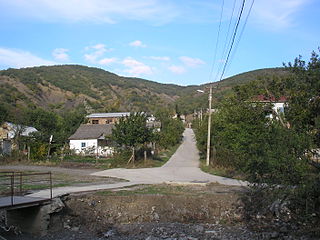
Hromivka or Gromovka is a village in the Sudak Municipality of the Crimea, a territory recognized by a majority of countries as part of Ukraine and annexed by Russia as the Republic of Crimea.
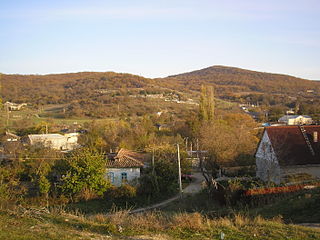
Hrushivka or Grushevka is a village in the Sudak Municipality of the Crimea, a territory recognized by a majority of countries as part of Ukraine and annexed by Russia as the Republic of Crimea.
Kholodivka or Kholodovka is a village in the Sudak Municipality of the Crimea, a territory recognized by a majority of countries as part of Ukraine and annexed by Russia as the Republic of Crimea.
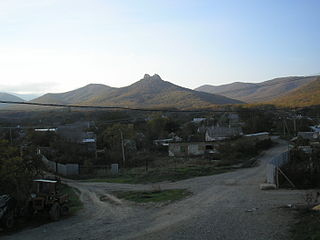
Lisne or Lesnoye is a village in the Sudak Municipality of the Crimea, a territory recognized by a majority of countries as part of Ukraine and annexed by Russia as the Republic of Crimea.
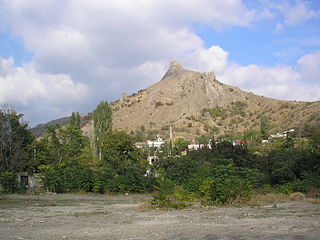
Mizhrichchia or Mezhdurechye is a village in the Feodosia Raion of Crimea, a territory recognized by a majority of countries as part of Ukraine and annexed by Russia as the Republic of Crimea.
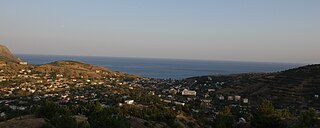
Morske or Morskoye is a village in the Sudak Municipality of the Crimea, a territory recognized by a majority of countries as part of Ukraine and annexed by Russia as the Republic of Crimea.

Perevalivka is a village in the Sudak Municipality of the Autonomous Republic of Crimea, a territory recognized by a majority of countries as part of Ukraine and annexed by Russia as the Republic of Crimea.














